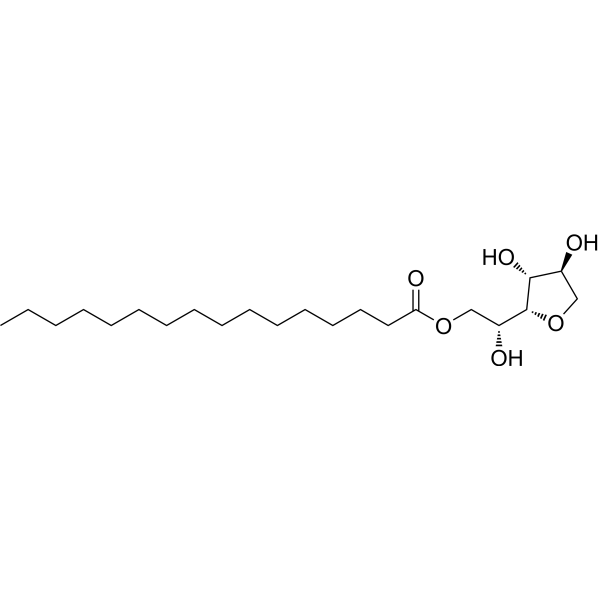Span 40

Span 40 structure
|
Common Name | Span 40 | ||
|---|---|---|---|---|
| CAS Number | 26266-57-9 | Molecular Weight | 402.565 | |
| Density | 1.1±0.1 g/cm3 | Boiling Point | 558.2±45.0 °C at 760 mmHg | |
| Molecular Formula | C22H42O6 | Melting Point | 46-47 °C(lit.) | |
| MSDS | USA | Flash Point | 182.4±22.2 °C | |
|
Chemical compositions and biological activities of the essential oils of Beilschmiedia madang Blume (Lauraceae).
Arch. Pharm. Res. 38(4) , 485-93, (2015) The present study aimed to examine the chemical compositions of the essential oils of Beilschmiedia madang and their antioxidant, antibacterial, antifungal, anticholinesterase and anti-tyrosinase activities. The major constituents of the essential oils of lea... |
|
|
Paclitaxel-loaded niosomes for intravenous administration: pharmacokinetics and tissue distribution in rats.
Turk. J. Med. Sci. 45 , 1403-12, (2016) The purpose of this study was to investigate and compare the pharmacokinetic behavior and tissue distribution of paclitaxel, delivered as commercial preparation Taxol or through Span 40 niosomes, after intravenous injection to rats.Paclitaxel-loaded Span 40 n... |
|
|
Conversion of polar and non-polar algae oil lipids to fatty acid methyl esters with solid acid catalysts--A model compound study.
Bioresour. Technol. 191 , 300-5, (2015) Bio-based fuels are becoming more and more important due to the depleting fossil resources. The production of biodiesel from algae oil is challenging compared to terrestrial vegetable oils, as algae oil consists of polar fatty acids, such as phospholipids and... |
|
|
Drug release from semisolid dosage forms: a comparison of two testing methods.
Pharm. Dev. Technol. 20(3) , 330-6, (2015) The aim of the present work was to extend our previous in-vitro drug release studies using semisolid dermatological bases with non-impregnated cellulose acetate membranes. A comparison of the performances of two apparatuses, the more commonly used Franz cell ... |
|
|
Preparation of curcuminoid niosomes for enhancement of skin permeation.
Pharmazie 66(8) , 570-5, (2011) Curcuminoids (curcumin, desmethoxycurcumin, and bisdesmethoxycurcumin) are major bioactive substances found in turmeric (Curcuma longa L.) extracts and possess antioxidant, anti-inflammatory, antimicrobial and anticancer properties. In this study, curcuminoid... |
|
|
The influence of surface properties on uptake of oil into complex coacervate microcapsules.
J. Pharm. Pharmacol. 46(8) , 631-5, (1994) A range of surfactants with different hydrophile-lipophile balance (HLB) values was selected to investigate the influence of interfacial properties on the uptake of oil droplets into complex coacervate microcapsules. The well characterized gelatin/acacia comp... |
|
|
Cationic liposomes modified with non-ionic surfactants as effective non-viral carrier for gene transfer.
Colloids Surf. B Biointerfaces 49(2) , 158-64, (2006) A defined change in formulation components affects the physical and chemical characteristics of cationic liposomes (CLs) carriers in many ways. Therefore, a great degree of control can be exercised over the structure by modifying the CLs with various material... |
|
|
Release Studies on Ciprofloxacin Loaded Non-ionic Surfactant Vesicles.
Avicenna J. Med. Biotechnol. 7 , 69-75, (2015) Development of new drug carriers would be an interesting approach if it allowed increased efficacy of antibiotics and a reduction in doses, thus reducing the risk of developing resistance. As with most drug carriers, niosomes have been used to improve the sel... |
|
|
The composition of NF-defined emulsifiers: sorbitan monolaurate, monopalmitate, monostearate, monooleate, polysorbate 20, polysorbate 40, polysorbate 60, and polysorbate 80.
Drug Dev. Ind. Pharm. 24(11) , 1049-54, (1998) Using the analytical constants for sorbitan monolaurate, monopalmitate, monostearate, and monooleate given in the National Formulary (NF), calculations were carried out that indicated that these emulsifiers are esters of sorbitol mono- and dianhydrides. Contr... |
|
|
Amphiphilic gels as a potential carrier for topical drug delivery.
Drug Deliv. 14(2) , 75-85, (2007) This study involves development of amphiphilic gels consisting solely of nonionic surfactants bearing cyclosporine and characterized for microstructure, gelation temperature, and in vitro drug release into dermis. The formulation is nonirritant and suitable f... |